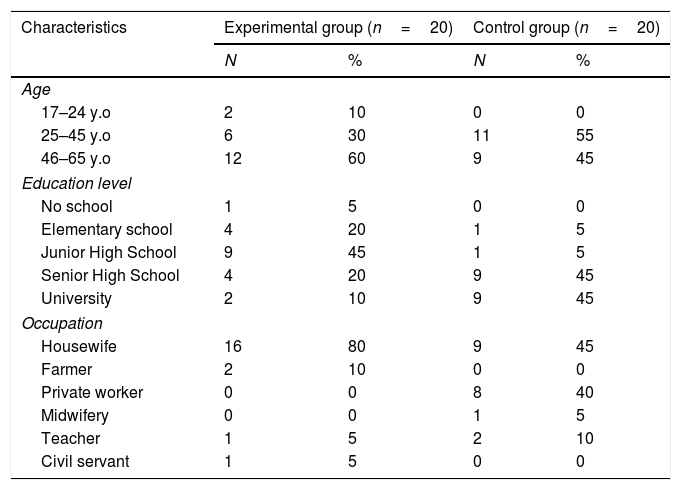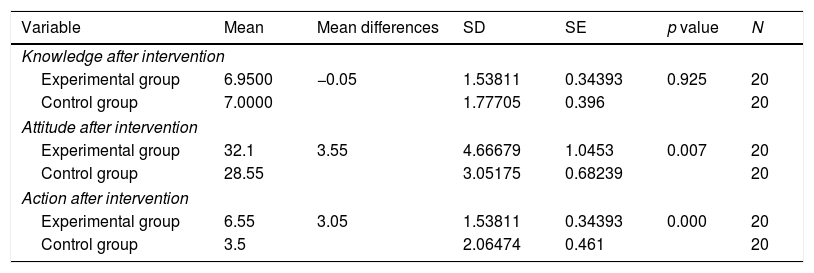This study aims to determine the effectiveness of health education through audiovisual media on improving family knowledge in the prevention of dengue fever (DHF).
MethodThis study used a Quasi Experiment research design with a research design of Non-Equivalent Control Group. The study was conducted in the community with a sample of 40 people, consisting of 20 for experimental group and 20 for control group. The samples were selected using purposive sample collection method. The measuring instrument used is a questionnaire that has been tested for validity and reliability. The analysis was done through univariate analysis and bivariate analysis using t-independent test.
ResultThis study found that the showed a significant increase in changes in the level of attitudes and actions of families in the prevention of dengue fever by using audiovisual media, (p=0.000), (p=0.000).
ConclusionIt is recommended that the health workers should provide health education by using audiovisual media in the prevention of dengue fever.
Dengue Hemorrhagic Fever (DHF) is a disease caused by infection transmitted through Aedes Aegypti mosquito which is found in areas with tropical and subtropical climates. According to Vyas (2013), it occurs on islands in Indonesia to the northern part of Australia. Since before 1970 until now, DHF has become an endemic disease in more than 100 countries. The countries that have the highest number of dengue cases include Africa, America, Eastern Mediterranean, Southeast Asia and the Western Pacific Approximately 500,000 patients with DHF require hospitalization each year, where the proportion of people are mostly children and 25% of whom have reportedly died.1
DHF currently is still one of the public health problems, especially for people in Indonesia. Since 1968, DHF has spread widely throughout Indonesia (Ministry of Health, 2010). Poor environmental situation, unhealthy people behavior, the behavior in the house during the day and a population density are some other factors of the cause of DHF.2 DHF is also one of the diseases that has a very fast process and many patients’ death because of slow treatment.3
Community behavior has an important role in dengue transmission. The community should have adequate knowledge, positive attitudes, and good practices in preventing the DFH diseases. Positive community behavior includes efforts to drain, close, and bury action. Community behavior efforts in eradicating dengue mosquito nests have not been realized optimally because there are still many trashes that are carelessly dumped around the yard such as used cans, tires that are not used. Shells are also still found as mosquito breeding sites. Some places are possible as a place to rest and a place for mosquito breeding such as dispenser shelters and puddles outside the house such as in flower pots that will cause puddles. Mosquitoes inside and outside the house are the factors that cause high rates of dengue disease.4
Even though various health promotions have been done by the government to increase the behavior, preventing such a negative behavior from the community is still far from expected. The number of dengue fever patients always increase every year. For this reason, this study was done by doing health education through audiovisual media to promote the family behavior. The purpose of this study was to assess the effect of providing health education through audiovisual media for improving family behavior in the prevention of DHF disease.
MethodThis study was a quasi experiment research design with non-equivalent control group, conducted from June to August 2018 in Kempas Jaya Public Health Center (PHC), Inhil District. This area is one of rural areas in Riau Province, Indonesia. There were 40 respondents (20 for experimental group and 20 for control group) consisting of families who lived in the PHC working area. They were selected using purposive sampling method. The questionnaires had been tested for validity and reliability. They consist of knowledge, attitudes, and actions regarding DHF prevention along with the family's ability to look after DHF. Data was analyzed using an independent T test to measure the mean differences of respondents between intervention and control group after the intervention using audio visual media.
ResultsTable 1 shows that the oldest respondents in the experimental group was 45–65 years (60%) and 25–45 years (55%) for control group. In terms of educational background, most of the respondents graduated from junior high school (45%) and senior high school and university (55%). In terms of occupation, majority of respondents were housewives (80% and 45% respectively).
Respondent characteristics.
| Characteristics | Experimental group (n=20) | Control group (n=20) | ||
|---|---|---|---|---|
| N | % | N | % | |
| Age | ||||
| 17–24 y.o | 2 | 10 | 0 | 0 |
| 25–45 y.o | 6 | 30 | 11 | 55 |
| 46–65 y.o | 12 | 60 | 9 | 45 |
| Education level | ||||
| No school | 1 | 5 | 0 | 0 |
| Elementary school | 4 | 20 | 1 | 5 |
| Junior High School | 9 | 45 | 1 | 5 |
| Senior High School | 4 | 20 | 9 | 45 |
| University | 2 | 10 | 9 | 45 |
| Occupation | ||||
| Housewife | 16 | 80 | 9 | 45 |
| Farmer | 2 | 10 | 0 | 0 |
| Private worker | 0 | 0 | 8 | 40 |
| Midwifery | 0 | 0 | 1 | 5 |
| Teacher | 1 | 5 | 2 | 10 |
| Civil servant | 1 | 5 | 0 | 0 |
Table 2 shows the results of bivariate analysis with Independent t-test that there was no significant difference between respondents’ knowledge after health education between the experimental group and the control group with p value 0.925 (p value >α). The mean difference was −0.05 showing that the experimental group has a smaller mean than the control group. Furthermore, Table 2 shows that there was a significant difference between the attitudes and actions of respondents after health education between the experimental group and the control group with p value of 0.007 and 0.000. The mean difference was 3.55 and 3.05, meaning that the experimental group has a greater mean value than the control group.
The mean difference of knowledge, attitude, and action of respondents between experimental and control group after health promotion by audio visual media.
| Variable | Mean | Mean differences | SD | SE | p value | N |
|---|---|---|---|---|---|---|
| Knowledge after intervention | ||||||
| Experimental group | 6.9500 | −0.05 | 1.53811 | 0.34393 | 0.925 | 20 |
| Control group | 7.0000 | 1.77705 | 0.396 | 20 | ||
| Attitude after intervention | ||||||
| Experimental group | 32.1 | 3.55 | 4.66679 | 1.0453 | 0.007 | 20 |
| Control group | 28.55 | 3.05175 | 0.68239 | 20 | ||
| Action after intervention | ||||||
| Experimental group | 6.55 | 3.05 | 1.53811 | 0.34393 | 0.000 | 20 |
| Control group | 3.5 | 2.06474 | 0.461 | 20 | ||
Attitudes and actions in this study indicate the mean difference between the experimental group and the control group after health education using audio visual media. Audio visual media is one of the media that presents information or messages in an audio visual manner. Audio visuals significantly contribute to changes the people's behavior, especially in the aspects of information and persuasion. This media provides a stimulus to hearing and vision, so that the results obtained are maximized. These results can be achieved because the senses that channel most of the knowledge to the brain are through eyes (approximately 75% to 87%), while 13% to 25% of knowledge is obtained or channeled through other senses.5
Knowledge is a result of human sense that is strongly influenced by the intensity of attention and perception of objects.6 The knowledge can be increased by audiovisual media. The mean level of knowledge of respondents in the experimental group and the control group are 6.95 and 7.00 respectively after the intervention. There is a difference of mean knowledge of respondents, but there is no significant different (p value of 0.92). This result finding is contradictory to a theory by Kamil7 who argue that the knowledge can be increased through training or counseling. This is probably due to the situation of respondents in the experimental group got less support when collecting the data after the intervention in health examination activities.
Although the difference mean of respondent's knowledge has no significant difference between experimental and control group after the intervention, the mean of attitude and actions of respondents in the prevention of DHF had a significant difference compared to the mean with the experimental and control group. The increase of the quality of attitude shows that the counseling provided can be directly accepted by the respondents. Attitude is a person's closed response to a particular stimulus or object that involves the factors of opinion and emotions in question.6 According to,8 attitudes can be improved through training and counseling by paying attention to their effectiveness. Davis9 revealed that media involving more senses is more influential than written media. Notoatmodjo6 suggests that information will be stored as much as 20% if delivered through audiovisual media and 70% if implemented in real practice. Furthermore, Maulana (2009) shows that the most transmitting knowledge to the brain is through the eyes, which is about 75% to 87%. Audiovisual media provides stimulation through the eyes and ears. The more senses stimulated, the easier the entry of information would be. The combination of information channels through the eyes (75%) and the ears (13%) will provide stimuli that are good enough to provide optimal results.
Furthermore, this study shows that the use of audiovisual media has a significant difference of mean in preventing for dengue disease in the experimental group. Providing information about health with audiovisual media is a learning process to develop the right understanding and the right actions for health. Study also supports that health promotion with audio visual media can transform in appropriate behavior to the right ones.
ConclusionThe use of audiovisual is very appropriate media to change family behavior in this study including attitudes and action to prevent the dengue disease. Through using audio visual as health promotion media, the mean attitudes and actions of respondents in this study were different after the intervention between the experimental group and the control group.
We would like to thank all respondents who have participated in this research. Our gratitude also goes to all those who have supported us during the collection of research data.
Peer-review of abstracts of the articles is under the responsibility of the Scientific Committee of Riau International Nursing Conference 2018. Full-text and the content of it is under responsibility of authors of the article.








